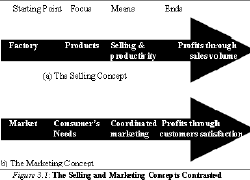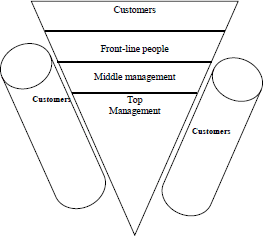Every profession has its own guiding principles that help to achieve its set goals; marketing is not an exception. These philosophies are the bases upon which marketing activities revolved. Successful marketing executives, critically, study these concepts and apply them where necessary, in order to achieve set goals.
These philosophies are called Marketing Concepts- the core of the marketing activities of organizations. It should, however, be noted that marketing management is a branch of marketing that deals with analysis, planning, implementation and control of programs; these programs are designed to create, build and maintain beneficial exchanges with target buyers for the purpose of achieving organizational objectives.
1. The Production Concept
The production concept holds that consumers will value products that are available and highly affordable, and that management therefore should focus on improving production and distribution, efficiently. This concept is one of the oldest philosophies that guide sellers.
The production concept is a useful philosophy which applies to the following situation:
a) When the demand for a product exceeds the supply- this is very common to most of the goods/services available in Nigerian markets; examples of these are petroleum products, food stuffs, and educational resources. It therefore implies that management should look for ways of increasing production of such products.
b) When the product’s cost is too high and improved productivity is needed to bring it down- for example, Henry Ford’s whole philosophy was to perfect the production of the model ‘T’ so that its cost could be reduced and more people could afford it.
Another example is the cost of earlier mobile phones and their accessories. They were very costly and access was limited to only few privileged individuals as compared to the present situation whereby an average individual has one. In order to maintain market turnover, it thus implies that management should improve facilities and reduce prices of their products/services- as obtained in the telecommunication market.
2. The Product Concept
The product concept holds that consumers will value products that offer the highest quality, performance, and innovative features; and that an organization should, thus, devote energy to making continuous product improvements.
In modern marketing, the product concept plays an important role.
This is because consumers are diverse in their needs and wants- sparsely distributed. Thus, they need to be served based on the peculiarity of their needs and environmental consideration.
For example, Toyota and Honda companies adopt this concept for their brands of cars for Nigerian markets. In the hospitality industry, services are provided based on the expectation of guests. This is why rooms are not charged equally.
Read Also: 5 Ways to Make Money Online this Year
However, marketing executives should be careful in applying this concept. Quality and innovative features may involve additional production costs, which in the long- run the consumers may be compelled to bear the burden. Thus, income of the consumers and their willingness to pay for these new features should be given consideration.
Otherwise, the product concept can lead to ‘market myopia’.
For instance, rail road management once thought that users wanted trains rather than transportation and overlooked the growing challenge of airlines, buses, trucks and automobiles.
In this same way, many colleges have assumed that high school graduates want a liberal arts education, and thus, overlooked the increasing challenge of vocational schools.
3. The Selling Concept
The selling concept or sales concept is another common approach adopted by some firms in penetrating their target markets. The selling concept holds that consumers, if left alone, will ordinarily not buy enough of an organization’s products. The organization must, therefore, undertake an aggressive selling and promotion efforts.
The concept assumes that the consumers’ resistance has to be overcome and the consumers should be coerced into buying more; and that the company has to use various strategies of effective selling and promotion tools to stimulate more buying.
The selling concept is practiced both by profit and non-profit making organizations. For instance, the selling concept is practiced aggressively with ‘unsought goods’ those goods that buyers, normally, do not think of buying, such as insurance policies, and thus, various sales techniques are used to locate potential and prospective buyers.
In addition, in automobile industries, the moment the customers walk into the show room, the auto-salesperson ‘psyches him out’.
If the customer likes the ‘floor model’, he may be told that there is another customer about to buy it, and that he should decide now. If the customer balks at the price, the salesperson offers to talk to the manager to get a special concession.
The customer waits a little and the salesperson returns with a response like-‘the boss does not like it, but I got him to agree’. The aim is to ‘work up the customer and close the sale’.
The selling concept is also practiced by non-profit organizations such as fund raisers, colleges/universities, politicians, and a host of others. For example, a political party will, vigorously, sell her candidates to the electorates as the best candidate for the position/job as is the practice with PDP, ANPP, AC, etc.
After the election, the elected officials continue to take a sales-oriented approach to deal with the citizens. There is little research into what the public wants, rather the political class adopts the selling concept to get the public to accept their policies- as practiced by the largest party in Africa-PDP.
Most firms practice the selling concept when they have a surplus of production. They aim to sell what they have, rather than make what they can sell.
In modern economy, productive capacity have been built up to a point where most markets are buyers’ markets, thus, sellers have to scramble hard for customers.
Prospects are bombarded with television commercials, newspaper adverts, direct mail and sales calls. At every turn, someone is trying to sell something. As a result, the public identifies marketing with hard selling and advertising as obtained in the baking and telecommunication industry.
For example, there is what is called ‘target’ in the banking industry in Nigeria, whereby the bankers or salesperson must get customers for the bank, irrespective of whether the customer has an interest in the bank or not.
However, for selling to be effective, it must be preceded by several marketing activities such as need assessment, marketing research, product development, pricing and distribution. If marketers do a good job by identifying customers’ needs, developing appropriate products and pricing, distributing and promoting them effectively, thus, products may sell very well.
Read Also: 14 Marketing Strategies and its importance in Business

4. The Marketing Concept
The marketing concept is a business philosophy that evolved to challenge the previous concepts. The marketing concept holds that the key in achieving organizational goals consists in determining the needs and wants of target markets and delivering the desired satisfactions, more effectively and efficiently than other competitors. Examples of marketing concepts relates to the following:
i) Find wants and fulfill them
ii) Make what will sell, instead of trying to sell what you can make
iii) Love the customer and not the product etc.

a) Selling focuses on the needs of the sellers; marketing focus on the needs of the buyers.
b) Selling is pre-occupied with the sellers’ need to convert his/her product into cash; while marketing has to do with the idea of satisfying the needs of customers by means of the product and the whole cluster of things associated with creating, delivery and finally consuming it.
c) In selling, management is sales-volume oriented; while in marketing, management is profit oriented.
d) In selling, planning is short-run oriented in terms of today’s products and markets.
However, in marketing, planning is long-run-oriented- in terms of new products, tomorrow’s markets, and future growth. (That is, the marketing concept is a philosophy of business that states that the satisfaction of customers’ wants- is the economic and social justification for a firm’s existence). This, thus, implies that all company activities must be devoted to finding out what the customers want and then satisfying those wants while making profits in the long run.
The marketing concept rests on four main pillars, namely:
- a market focus
- customer orientation
- coordinated marketing, and
- profitability
These concepts are briefly examined below:
a) Market focus- no company can operate in every market and satisfy every need; nor can it do a good job within one broad market. For example, in the automobile industry, Toyota has a variety of brands of all kinds to satisfy their target markets, e.g. luxury buses, passenger buses, etc. Also, in the soft drink industry, Coca-Cola Nigeria Plc has 25cl and 35cl brands for its target markets.
b) Customer orientation- a company can define its market carefully, and still fail at customer-oriented initiatives. Customer-oriented thinking requires the company to define customer needs from the customer’s point of view, not from its point of view. Every product involves trade-offs, and management cannot know what these are, without talking to a customer and researching customers’ needs.
For instance, a car buyer (Toyota) would like a high-performance car that would never break down- a brand that is attractively styled and cheap. Since all of these features may not be in one car, car designers must make hard choices, not on what pleases them, but rather on what customers prefer or expect. The aim, after all, is to make a sale by meeting the needs of customers.
One may ask this question-why is it important to satisfy customers? It should, however, be noted that a company’s sales- each period, come from two groups- new customers and repeat purchase customers.
It always costs more to attract new customers than to retain current customers. Hence, customer retention is more critical than customer attraction.
The key to customer retention is customer satisfaction. Satisfied customers do the following:
- They buy again
- Talk favorably to others about the company.
- Pay less attention to competitive brands and advertisements.
- Buy other products from the same company.
To buttress these views, according to one Japanese businessman the aim of every business concern should go beyond satisfying customers- the focus should be to delight the customer.
Salespeople go beyond meeting the mere expectations of the customer; when they delight a customer, the customer talks to more acquaintances about the company. Delighted customers are more effective advertisers than the advertisements placed in the media.
Consequently, when a company creates a dissatisfied customer, it and its feelings with others without being asked. This is because, bad words travel faster and further than good words, and can easily poison the public’s attitude about the company. In summary, a customer-oriented company will track its customer satisfaction level, each period, and set improvement goals.
Read Also: Benefits of a Growing Business
c) Coordinated marketing – Coordinated marketing means two things, as you are going to see below.
I) The various marketing functions- sales force, advertising, product management, marketing research, and a host of others, must be coordinated altogether. These marketing functions must be coordinated from the customer’s point of view.
II) Marketing must be well coordinated with the activities of other departments of the company. Marketing does not work when it is merely a department; it only works when all employees appreciate the effects they have on customer satisfaction.
Let us examine the following case-a story about how Bill Marriott Jr. (Chairman of Marriott Hotels) interviews prospective managers:
Bill Marriott, tells the job candidate that the hotel chain wants to satisfy three groups- customers, employees, and stakeholders. While all the groups are important, he would ask – in what order should the groups be satisfied? Most candidates say the customers should be satisfied first. Bill Marriott, however, reasons differently. The order should be first- the employees; if the employees love their jobs and feel a sense of pride in the hotel, they will serve customers well. Satisfied customers will return frequently to Marriott. This repeat business, in turn, yields a level of profits that satisfies the Marriott stockholders.
In summary, Bill Marriott is still saying that the customer is the key to profitability. This is further stressed in the diagram below.

From the diagram above, at the top of the organization are the customers. Next in importance are the front-line people, who meet, serve and satisfy the customers.
Under them are the middle-level managers, whose job is to support the front-line people so that they can serve customers better; and finally, at the base is the top management, whose job is to support the middle managers, so that they can support the front-line people, who make all the difference in whether the customers end up feeling satisfied with the company.
You would also notice that customers are found by the sides, which indicate that all the managers in the company are, personally, involved in knowing, meeting and servicing customers’ needs, effectively.
d) Profitability- the purpose of the marketing concept is to help organizations to achieve their goals. In private firms, the major goal is profit, while in non-profit and public organizations; the goal is surviving and attracting enough funds to perform their work. In essence, the key is not to aim for profits as such, but to achieve them as a by-product of doing the job well. For example, the General Motors executive said- “we are in the business of making money, not cars”; here, he is misplacing the emphasis.
A company makes money by satisfying customer needs better than competitors. This is not saying that marketers are unconcerned with ‘profits’. Quite the contrary, they are highly involved in analyzing the profit potential of different marketing opportunities. The sales- force/people focus on achieving sales volume goals while marketing people focus on identifying profit-making opportunities.
5. Organizational resistance
Some departments in a company, often manufacturing, finance, etc. Do not like to see marketing built up, because it threatens their influence in the organization, allegedly.
However, it has been argued that “marketing is the major function of an enterprise- for, without customers, there will be no company”. This implies that marketing is put at the center, with other business functions serving as supporting functions.
The marketer’s argument for the business concept is outlined below:
1) The assets of the firm have little value without the existence of customers.
2) The key task of the firm is therefore to attract and retain customers.
3) Customers are attracted through, competitively, superior offers, and retained through satisfaction.
3)Marketing’s task is to define a superior offer to the customer and to ensure the delivery of satisfaction.
4) The satisfaction received by the customer is affected by the performance of the other departments.
Marketing must influence or control these other departments if customers are to receive the expected satisfaction.
Despite these arguments, marketing is still resisted by some organizations.
6. The Societal Marketing Concept
The societal marketing concept holds that the organization should determine the needs, wants, and interests of target markets. It should then deliver the desired satisfactions, more effectively and efficiently than competitors. The societal marketing concept is the newest of the five marketing management philosophies.
The societal marketing concept questions whether the pure marketing concept is adequate in an age of environmental problems, resource wastages, rapid population growth, worldwide economic crisis, and neglected social services.
The societal marketing holds that a pure marketing concept overlooks possible conflicts between short-run runner wants and long-long-runner welfare. According to Kotler (1994), most people see the “Coca-Cola Company” as a highly responsible corporation, producing good soft drinks that satisfy consumers.
Yet, certain consumer and environmental groups have voiced the concerns that Coke has little nutritional value, that it can harm people’s teeth, contains caffeine, and adds to the little problem with disposable bottles and cars. Similarly, the Niger-delta, South-South of Nigeria has cried out over the unwholesome activities of oil companies, thus leading to all forms of human degradation.
In summary, the study of marketing will be incomplete without the study of marketing orientations. This is because it is the basis of marketing itself. This unit exposes you to the production, product, selling, marketing, and societal marketing concepts as the basis of understanding marketing activities.
Read Also: The Habits of Successful Business Owners
